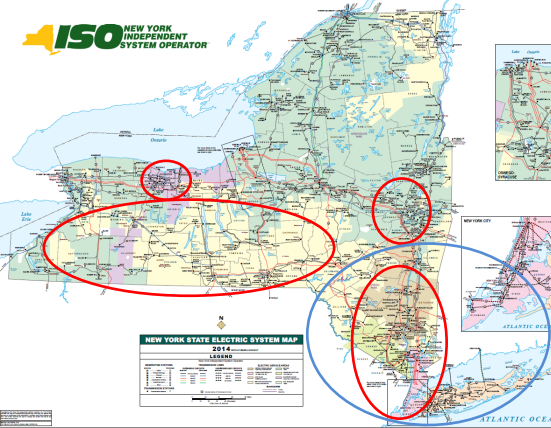By William Opalka

Locations of transmission security needs. (Source: NYISO)
Some areas of New York could face transmission violations as soon as next year and capacity shortages are likely by 2019 — one year earlier than expected — according to NYISO’s latest Reliability Needs Assessment.
“These reliability needs are generally driven by recent and proposed generator retirements or mothballing combined with load growth,” the report says.
Transmission security violations could occur as soon as next year in Rochester, Western & Central New York, the Capital Region, the Lower Hudson Valley and New York City.
Generation resources needed to keep reserve margins above 17% will fall short in about 2019 and get worse from then on, the document states. This is a year earlier than the ISO’s 2012 assessment predicted. “The most significant difference between the 2012 RNA and the 2014 RNA is the decrease of [New York’s] capacity,” the new assessment says.
This summer’s Installed Capacity Reserve was at 122.7%, well above the 117% margin reserve requirement. But the new report shows the ISO’s 2019 margin as 2,100 MW less than what was expected in the 2012 report. The change resulted from increased load growth and a decline in capacity resources and special-case resources — end-use resources that can be interrupted on demand.
The NYISO Management Committee approved the analysis, the first step in assessing the state’s reliability needs from 2015 to 2024, on Aug. 27. The Board of Directors will review the report in October, after which the ISO will issue requests for solutions from transmission operators and developers.
Additional generation plants could delay the shortfall beyond 2019, NYISO said.
Some of the transmission constraints in western New York would be mitigated by the repowering of the mothballed Dunkirk power plant. State regulators and plant owner NRG have agreed on a plan to convert the former coal plant to 435 MW of natural gas-fired electricity in late 2015.
NYISO also expects market rule changes, such as the creation of a new capacity zone in the Lower Hudson Valley, to entice generation owners to add additional capacity in Southeastern New York. Opponents say the zone represents a windfall for existing power plant owners, who will benefit long before any new generation plants are built.
The ISO said generation capacity could be reduced more than expected as a result of the Environmental Protection Agency’s Mercury and Air Toxics Standard, which takes effect next year, and proposed caps on carbon emissions.
Compared with the previous assessment, the new report predicts the following for 2019:
- Capacity resources decline by 874 MW (724 MW upstate and 150 MW in SENY)
- Baseline load forecast increases by 250 MW (497 MW higher upstate and 247 MW lower in SENY)
- Special-case resources drop 976 MW (685 MW upstate and 291 MW in SENY).

